
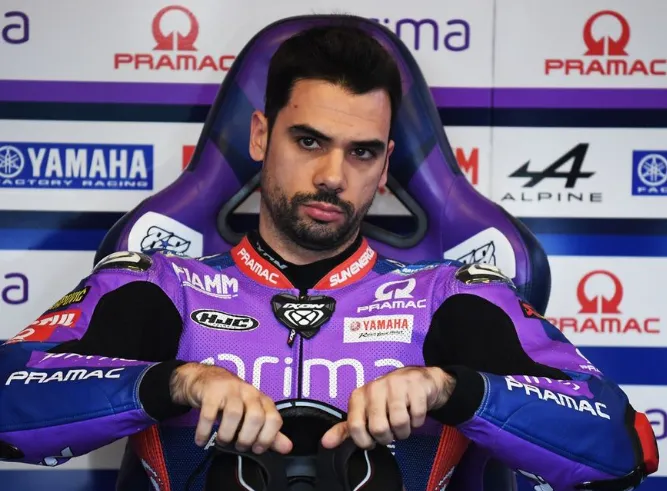
“Very Hard to Keep the Bike Going Straight” – Miguel Oliveira Reveals the Balancing Challenge of the M1 That Shocked Fans!
Miguel Oliveira’s 15th-place finish at the Aragon Grand Prix barely tells the full story of a weekend riddled with mechanical and performance frustrations—not only for him, but for the entire Yamaha MotoGP camp. As Fabio Quartararo crashed out while battling severe chatter problems, Oliveira encountered front brake locking and balance issues that rendered his Pramac Yamaha M1 difficult to handle, especially during the early laps when the bike was full of fuel.
While Yamaha entered the 2025 season with hopes of revitalizing its MotoGP fortunes, the Aragon GP exposed deeper structural issues, from weight distribution inconsistencies to grip unpredictability. Both factory and satellite riders are now sounding alarm bells, emphasizing the urgent need for development before heading into races like Mugello and Assen.
Miguel Oliveira’s Struggles: “Very Difficult to Keep the Bike on Track”
After a weekend where Oliveira could barely extract consistent performance from his M1, the Portuguese rider opened up about a host of technical problems that left him floundering in the lower midfield.
“It was very difficult to keep the bike on track in the first 10 laps,” Oliveira said post-race.
“The biggest issue for me was also the front locking at the beginning of the race, mid-race, as the bike was unbalanced between a full tank and then an empty one.”
Oliveira described how the balance of the M1 changed dramatically as the fuel load decreased. The front end, already light and unstable with a full tank, became slightly more manageable halfway through the race. But by then, the time lost was already too great to mount any significant charge up the order.
This discrepancy in bike behavior between the start and the middle of the race is now a major red flag for the Pramac Yamaha team. If the M1 cannot maintain a consistent geometry and weight balance throughout race conditions, riders are left gambling with their grip and stability on every lap.

Front Brake Locking: A Dangerous Limitation
Oliveira revealed that one of the most hazardous issues he faced was front brake locking, particularly during the opening laps.
“Front locking was my main challenge, especially early in the race,” he explained.
“The bike was unbalanced, and it made the front end extremely unpredictable.”
This problem not only made it hard for Oliveira to trail-brake with confidence into corners but also forced him to ride defensively, which severely compromised his race pace. He admitted that once the fuel load lightened, the M1 became easier to handle, but the improvement came too late.
In contrast to chatter problems that have haunted factory teammate Fabio Quartararo, Oliveira’s issue may stem more from braking hardware and geometry. Nonetheless, it adds to the laundry list of Yamaha’s 2025 MotoGP woes.
Inconsistent Handling: Faster Laps, Less Effort, and Less Grip?
What makes Oliveira’s experience even more bizarre is the behavior of the bike mid-race. As fuel burned off, he began to set faster lap times, despite having less grip and applying less physical effort.
“It became easier as soon as the weight dropped. We were setting faster laps with less grip, which was strange,” Oliveira noted.
This observation reflects anomalies in the M1’s chassis and setup that may point to deep-rooted flaws in weight transfer, suspension dynamics, or fuel tank design. A competitive MotoGP machine must deliver predictable behavior over a full race distance, and that’s something Yamaha currently fails to offer either to its factory or satellite riders.
Time Attacks and Qualifying: Another Weak Link
Beyond race-day performance, Oliveira also criticized Yamaha’s inability to perform in time attack mode during qualifying.
“This is where we struggled most this weekend, in terms of positioning ourselves better at the start of the race and avoiding some of the chaos at the back of the grid,” he said.
Poor qualifying results meant Oliveira had to fight in the chaos of the mid-pack, where the front brake locking and poor balance issues became even more dangerous. When asked if these problems also existed in the Sprint race, he confirmed:
“Yes. I mean, the Sprint is the same. The weight distribution is the same.”
This lack of adaptability across both race formats further cements Yamaha’s ongoing troubles.
Fabio Quartararo’s Crash: A Parallel Crisis for Yamaha
While Oliveira grappled with braking and balance, Fabio Quartararo’s race ended in the gravel at Turn 1 on Lap 13. The Frenchman, who had been running in 10th place, blamed severe rear chatter for his crash.
“Same as yesterday. Chatter on the rear. Locking on the front, no grip,” Quartararo summarized.
The 2021 world champion had experienced similar chatter during Saturday’s sprint, which pushed him outside the points. The return of the issue during the full race left Yamaha engineers scratching their heads, especially since Quartararo had opted for the medium rear tire, which traditionally does not provoke such chatter.
“Really Bad” Package: Aragon a Litmus Test for Yamaha’s 2025 M1
Quartararo was candid about how damaging the Aragon GP was for Yamaha’s development trajectory.
“This one for me was a little bit a point where we could really see our potential and see where we are,” he admitted.
“It was really bad.”
While some tracks may suit the M1 better, Quartararo stressed that Aragon exposed the weaknesses of Yamaha’s 2025 machine. With Mugello and Assen approaching, there’s cautious optimism, but even those circuits won’t mask the deeper issues if left unresolved.
Yamaha’s Crisis of Consistency: A Broader Picture
Between Oliveira’s brake and balance woes and Quartararo’s grip and chatter problems, a clear picture emerges: the 2025 Yamaha M1 suffers from inconsistencies in chassis balance, grip evolution, braking performance, and tire behavior.
These are not isolated incidents or setup mistakes. Instead, they indicate structural problems in the bike’s design philosophy, potentially in areas such as:
Fuel tank and weight distribution
Chassis stiffness and geometry
Brake hardware or front suspension characteristics
Tire pressure management across race stints
And this affects not only how riders qualify but also how they race—under full fuel, mid-race transitions, and tire degradation scenarios.
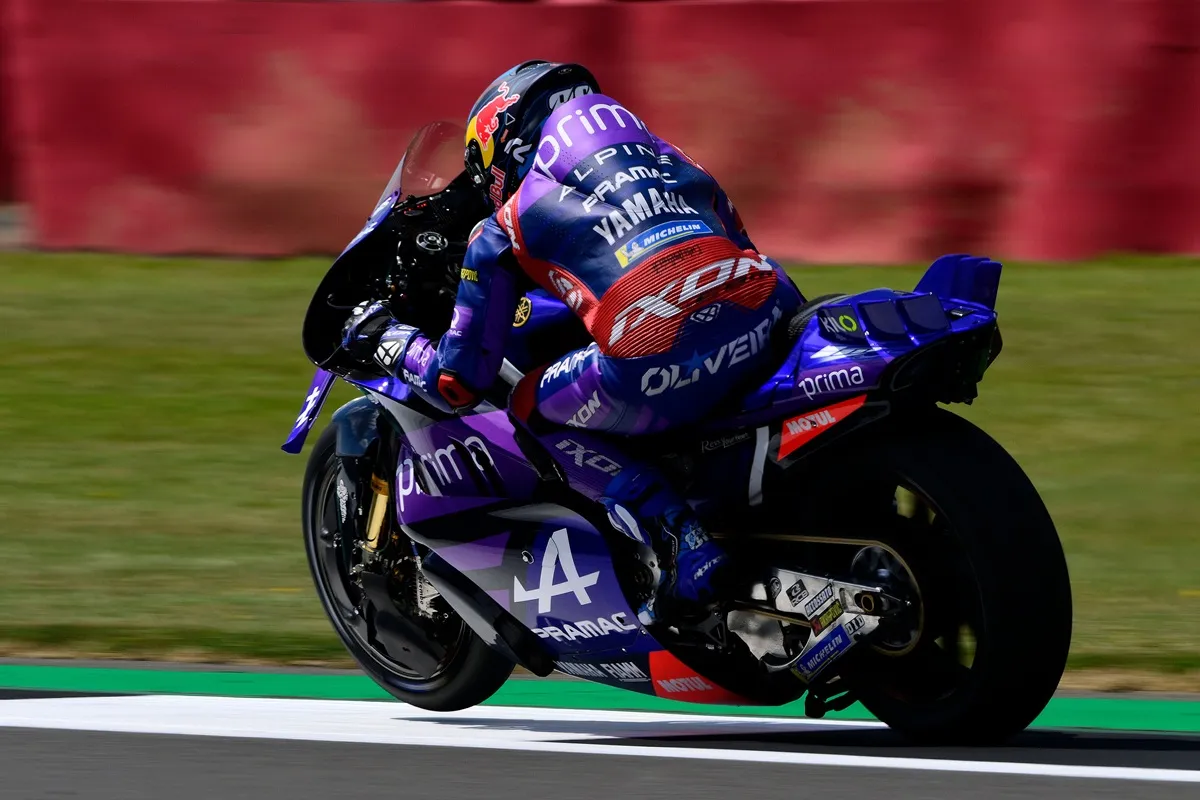
Oliveira’s Path Forward: “We’ll Address Some Areas Tomorrow”
Despite the grim outcome, Oliveira expressed confidence in the team’s willingness to tackle the issues.
“There’s definitely work to do here, and tomorrow we’ll address some areas we feel are necessary,” he said, referring to the post-race test session.
If Yamaha engineers are to avoid another disaster at Mugello or Assen, solving these braking and balance inconsistencies will be vital—not just for Oliveira’s competitiveness, but for the brand’s broader redemption arc.
Final Thoughts: A Struggling Legacy Manufacturer in Need of Urgency
Once a dominant force in MotoGP, Yamaha now finds itself on the back foot, plagued by technical inconsistencies and underperforming machinery. The Aragon GP served as a painful mirror, reflecting how far the Japanese giant has fallen behind rivals like Ducati, KTM, and Aprilia.
Miguel Oliveira and Fabio Quartararo are both world-class talents who deserve better machinery. Unless Yamaha can radically fix its chassis dynamics, tire behavior, and weight balance, podiums may remain out of reach—not just in 2025, but for seasons to come.




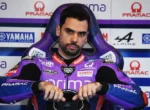



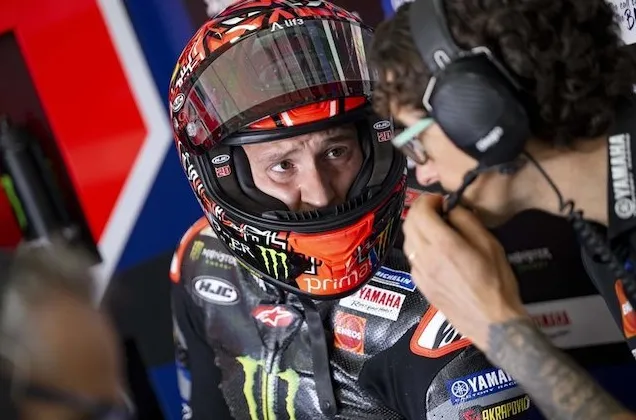

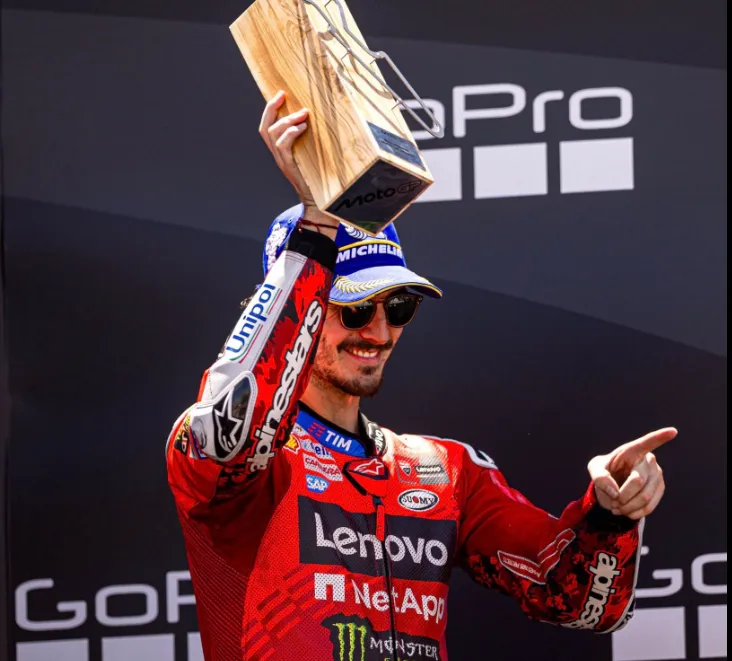








Post Comment